It my not clear to the average civilian, but not all fire trucks are the same. There are 7 different types of fire trucks, each with a unique purpose in fire and rescue operations. Here they are:
The 7 types of fire trucks are:
- Engine truck
- Ladder truck
- Rescue/special operations truck
- Brush truck
- Command vehicle
- Tiller
- Tanker/tender
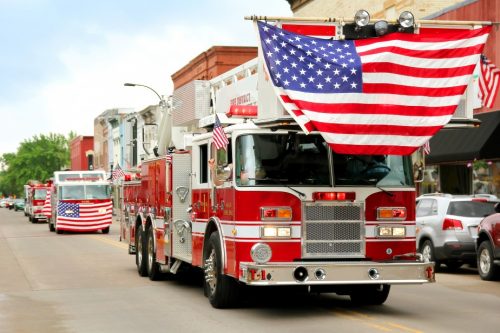
If you’re not familiar with the above types of fire trucks, then you’re in the right spot. We’ll discuss each of the fire trucks one at a time, clarifying the differences between each and explaining how they work.
The 7 Types of Fire Trucks and Their Purposes
Fire Engine
Starting with the big one, an engine truck is your typical fire engine. In some parts of the world, this vehicle is called a fire lorry, and in other parts, it’s referred to as a fire truck. As you can guess, the purpose of an engine truck is to transport the local fire department to the source of the fire.
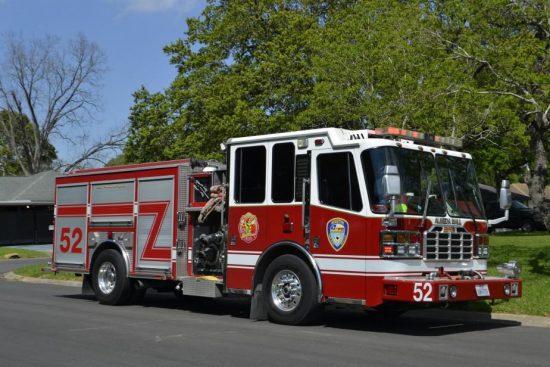
More so than that, engine trucks carry water–often hundreds of gallons at once–that the firefighters can use to contain the blaze once they arrive on the scene. Firefighting equipment can also fit on an engine truck.
Some of that equipment can include thermal imaging cameras, self-contained breathing apparatuses, fire extinguishers, fire hoses, floodlights, the jaws of life and other hydraulic rescue tools, and ladders.
An engine truck might contain a master stream or a fixed deluge gun. This piece of equipment allows the firefighters to blast water in the direction in which the gun is aimed. The inclusion of a fixed deluge gun helps the fire department begin combatting a fire as soon as they arrive without the need to uncurl hoses and attach them to a source of water.
Preconnects are another feature of some engine trucks. A preconnect is a hose line that’s already connected and ready to use, hence the name. The inclusion of a preconnect is another time-saving measure in the same vein as a fixed deluge gun.
Since preconnects don’t have an infinite source of water, once the water supply is gone, the firefighters could then use a water tender or a fire hydrant to continue sourcing water if necessary.
Besides conventional engine trucks, some are also aerial apparatus style. These trucks have a boom attached to them that can extend outward. When firefighters need to tamp down blazes in high-rises and other tall buildings, they’re likely to bring an aerial apparatus truck to the scene.
Although fire engine red is a color that’s worked its way into the vernacular of most people, not all engine trucks are red, far from it. Depending on the type of truck as well as the part of the world, fire engines can be red, yellow, pink, or orange.
Lime-yellow has become the color of choice for engine trucks lately because this color makes the vehicle more noticeable. The fire engine might be less likely to be in an accident.
Ladder Truck
Next is the ladder truck. Confusingly, some people call these vehicles fire trucks, which is a nickname for engine trucks as well. The main difference between a ladder truck and an engine truck is the inclusion of a hydraulic ladder.
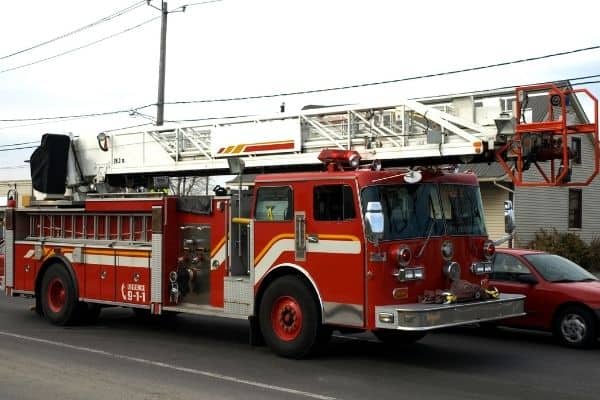
The ladder, which is the namesake of a ladder truck, allows firefighters to reach greater heights to rescue victims and put out fires from above.
It’s not that engine trucks don’t have ladders, but the firefighters have to set them up manually and carry them since these ladders are not hydraulically operable.
In addition to the hydraulic ladder, ladder trucks will also include ground ladders, several of these, which are different lengths so firefighters can use them to access small and large buildings alike.
Search and rescue equipment is common onboard these trucks, as is ventilation equipment and forcible entry tools. Some ladder trucks have turntables with a pivot that moves the ladder.
Turntable ladders on a ladder truck can be used as platforms or for elevating a master stream. The ladder telescopes using pneumatics or hydraulics while increasing the stability of the turntable ladder. Some turntable ladders include pre-attached hoses.
Depending on the placement of the turntable ladder, it can be right behind the truck’s cab (known as a mid-ship setup), in the middle of the truck, or at the chassis rear. A turntable ladder vehicle might include a water supply reservoir to track water as well as a water pump for blasting a fire with water.
If a turntable ladder has ground ladders, an aerial ladder, a fire hose, a water tank, and an onboard pump, then the vehicle isn’t called a ladder truck, but rather, a quint engine or a quad engine.
Rescue/Special Operations Truck
The third type of fire truck is a special operations truck, also known as a rescue truck. This technical vehicle is intended for transporting equipment for rescue operations. The range of equipment can include circular saws, cutting torches, cranes, high-lift jacks, winches, generators, wooden cribbing, and the jaws of life.
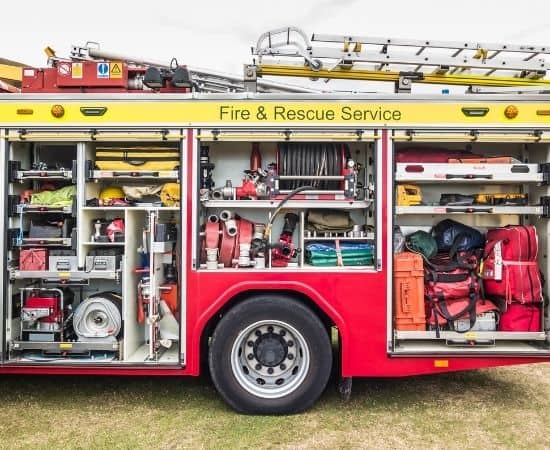
Although the jaws of life is transportable on engine trucks, the other equipment is considered too heavy for carrying on ladder trucks or fire engines. Thus, special operations trucks serve a unique purpose.
What these vehicles carry in equipment, they lack in water. A special operations truck is usually devoid of pumping gear as well as water tanks that engine trucks and ladder trucks will bring to the site of a fire or emergency.
To drive a rescue vehicle in the United States, you need to have EMT-Basic standard medical training or higher. Some firefighters might meet that requirement, but more than likely, it will be paramedics, emergency medical technicians or EMTs, or medical first responders who drive a special operations truck.
If not them, then a rescue squad will drive the special operations truck. The duties of a rescue squad are to provide life support to patients who are injured and/or ill. Rescue squads can include firefighters.
Special operations trucks are classed by weight, with at least three classes. Those are light, medium, and heavy. The tasks required of a special operations truck can vary depending on its weight. For example, a lightweight special operations truck cannot carry the breadth of life-saving equipment that these trucks are known for, so it might be used for other related purposes.
In some parts of the world, special operations trucks are named depending on their weight. A medium-sized truck would be known as a squad truck and a larger truck would be called a heavy rescue truck.
Brush Truck
The fourth type of fire truck is a brush truck, which is also called a wildland fire engine. If that name didn’t make it clear, the purpose of a brush truck is to get firefighters to the source of a wildfire, also known as a brushfire. A wildfire occurs in urban and rural areas and involves vegetation combusting.
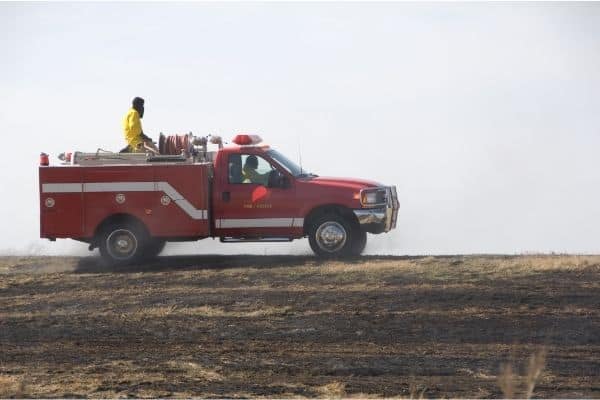
The United States Forest Service is likeliest to drive brush trucks, but firefighters can and do as well. Brush trucks include equipment and apparatuses attached to the vehicle. The amount of water a brush truck carries can sometimes be twice as much as a regular fire hose. This requires larger hose lays built into the vehicle.
Those responding to a brush fire will use techniques such as the pump and roll, which involves at least two firefighters.
Brush trucks are used when fire engines cannot reach the site of the fire. A wildland fire engine has four-wheel drive for traversing grassy terrain or areas of high vegetation. Fire engines don’t usually include four-wheel drive.
Fire engines will have to stop to pump water, but brush trucks can do it while moving. There are seven types of brush truck engines that determine the maximum water flow rate as well as whether it can do a pump and roll.
Command Vehicle
Fire command vehicles or just command vehicles are known as fly cars or fire chief’s cars. A fire department’s senior officer will always be behind the wheel of these vehicles. When a call comes into the department, the senior officer will respond, usually with engine trucks in tow.
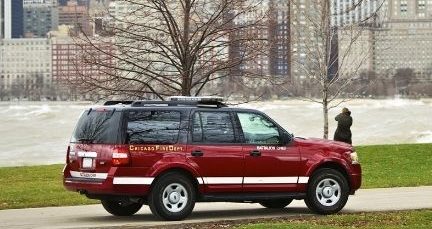
Command vehicles feature specialized markings so it’s clear that the senior officer is driving. Back in the 19th century, command vehicles were called chief’s buggies since they were horse-drawn buggies. These vehicles have certainly come a long way!
Tiller
Tillers are a fire truck that’s called a hook-and-ladder truck, a tiller ladder, or a tractor-drawn aerial vehicle in other parts of the world. Tillers feature turntable ladders like some ladder trucks. The turntable is attached to a pivot system on a semi-trailer.
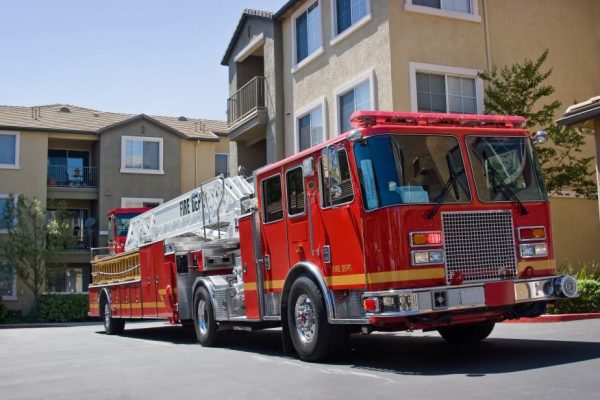
Both the tractor and trailer are stuck together, making tiller trucks far longer than the average fire engine. For comparison’s sake, some engine trucks are 10 feet long whereas a tiller is 60 feet. Unsurprisingly then, tillers require two drivers at once.
One driver controls the rear and front wheels of the tiller while the second driver handles steering. The two drivers must work seamlessly in conjunction with one another to pull off the safe operation of the tiller.
Despite that tillers seem like they’d be hard to maneuver, the opposite is true. The truck’s independent steering makes even sharp turns possible even though this is a longer fire vehicle.
Since tillers are so long, they have phenomenal storage capacity. All nature of firefighting equipment and tools can fit on this truck, as it can hold 40 to 60 cubic feet in its cab and then 500 to 650 cubic feet in its trailer.
Tiller-quints are a variation of the standard tiller that includes a water tank onboard the vehicle.
Tanker/Tender
The seventh and final type of fire truck is a tanker, which is also known as a water tender. This vehicle is meant only to send water so firefighters can utilize it. The source of the water can come from a fire hydrant or even nearby bodies of water such as a lake or a stream.
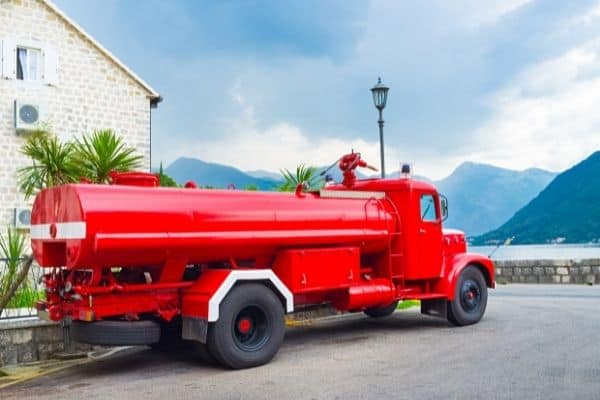
Although water tenders can’t transport plentiful water to a big hose line (the average amount of water is 2,600 gallons), the smaller pumps these vehicles use can come in handy. Many firefighters will rely on water tenders when they can’t access a fire hydrant or when the hydrant is not working.
Water tenders are not the sole vehicle responding to a fire call. Instead, they support fire engines or ladder trucks. Some bigger models can carry crew members as well as firefighting equipment. Others are a combination of water tender and fire truck with room for up to six crew members and the capacity to carry 2,900 gallons of water.
There you have it, the 7 types of fire trucks and the purposes for each. Now that you understand that every fire vehicle you see is not an engine truck, you can glean a greater appreciation for the many vehicle types that allow firefighters and rescue teams to do their jobs so diligently!